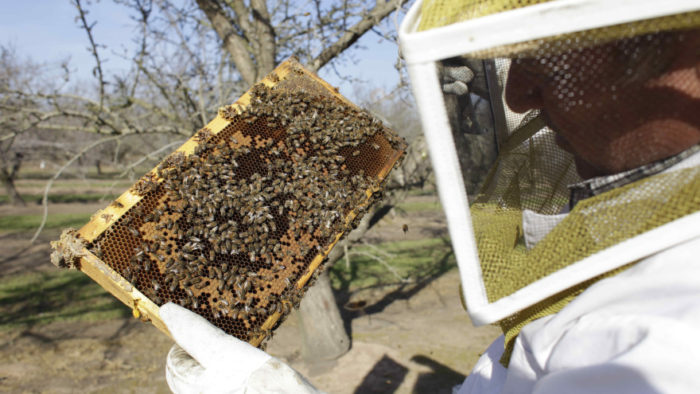Bees are being killed. But what is the origin of this mystery mass die-off?

The mysterious mass die-off of honey bees that pollinate $30 billion worth of crops in the US has so decimated America’s apis mellifera population that one bad winter could leave fields fallow. Now, a new study has pinpointed some of the probable causes of bee deaths and the rather scary results show that averting beemageddon will be much more difficult than previously thought.
Latest scientific results
Scientists had struggled to find the trigger for so-called Colony Collapse Disorder (CCD) that has wiped out an estimated 10 million beehives, worth $2 billion, over the past six years. Suspects have included pesticides, disease-bearing parasites and poor nutrition. But in a first-of-its-kind study published last July in the journal PLOS ONE, scientists at the University of Maryland and the US Department of Agriculture have identified a witch’s brew of pesticides and fungicides contaminating pollen that bees collect to feed their hives. The findings break new ground on why large numbers of bees are dying though they do not identify the specific cause of CCD, where an entire beehive dies at once.
When researchers collected pollen from hives on the east coast pollinating cranberry, watermelon and other crops and fed it to healthy bees, those bees showed a significant decline in their ability to resist infection by a parasite called Nosema ceranae. The parasite has been implicated in Colony Collapse Disorder though scientists took pains to point out that their findings do not directly link the pesticides to CCD. The pollen was contaminated on average with nine different pesticides and fungicides though scientists discovered 21 agricultural chemicals in one sample. Scientists identified eight ag chemicals associated with increased risk of infection by the parasite.
Fungicide vs parasite
Most disturbing, bees that ate pollen contaminated with fungicides were three times as likely to be infected by the parasite. Widely used, fungicides had been thought to be harmless for bees as they’re designed to kill fungus, not insects, on crops like apples. Labels on pesticides warn farmers not to spray when pollinating bees are in the vicinity but such precautions have not applied to fungicides.
The study found another complication in efforts to save the bees: US honey bees, which are descendants of European bees, do not bring home pollen from native North American crops but collect bee chow from nearby weeds and wildflowers. That pollen, however, was also contaminated with pesticides even though those plants were not the target of spraying.
Bee populations are so low in the US that it now takes 60% of the country’s surviving colonies just to pollinate one California crop, almonds. And that’s not just a west coast problem—California supplies 80% of the world’s almonds, a market worth $4 billion.













[…] October 21, 2013 -Bee Mass Die-Off: What’s Killing Bees is Worst Than What you Thought https://strangesounds.org/2013/10/bee-mass-die-off-whats-killing-bees-is-worst-than-what-you-thought.… […]
[…] October 21, 2013 -Bee Mass Die-Off: What’s Killing Bees is Worst Than What you Thought https://strangesounds.org/2013/10/bee-mass-die-off-whats-killing-bees-is-worst-than-what-you-thought.… […]
[…] https://strangesounds.org/2013/10/bee-mass-die-off-whats-killing-bees-is-worst-than-what-you-thought.… […]
[…] https://strangesounds.org/2013/10/bee-mass-die-off-whats-killing-bees-is-worst-than-what-you-thought.… Air Apocalypse in China: Super Smog Hits Harbin in North China […]